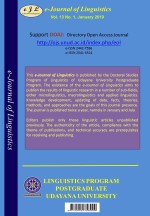Image Schema Analysis on Psalm 23: A Study of Metaphor Based on Cognitive Theory
Abstract
This article aims to identify what types of image schemas operating in Psalm 23 “The Lord is My Shepherd. This text is very old and full with metaphors. According to the theory of Conceptual Metaphor, metaphorical phenomena are not merely as a linguistic matter, but rather as a process of cognition by which humans understand the reality (Lakoff and Johnson,1980). Unconsciously, conceptual metaphor generates metaphorical expressions in our daily life. Behind the conceptual metaphor, there are image schemas serving as a pre-conceptual structure derived from physical experiences, cultural background, and ideology of a nation. Image-schema is a recurring structure within our cognitive process (Johnson,1987).
The Psalm 23 “The Lord is my Shepherd” consists of 6 verses, each may be contained of more than one sentence or phrase. It was written by King David about the fifth and the tenth century B.C. to show the goodness of God, and His close relationship with His people. God is portrayed as a good shepherd caring deeply to His cattle. Mapping method is adopted to construct the meaning of metaphor in which The Lord as Target Domain and Shepherd as Source Domain. Then, each verse is analyzed to find image schemas involved in the text. As the result, there are seven types of image schemas in Psalm 23: container, path, link, force, attraction, blockage, and removal of restraints. Based on these findings, it can be concluded that image schema as an elementary part of conceptual metaphor has potential to be an analysis tool to discover the meaning of metaphorical texts.
Downloads
References
Anderson, Albert. 1972. The Book of Psalms. London: Attic Press.
Ayu, Agung I Gusti. 2018. ”Naturalization and Adaptation Taking Place in Translation of Medical Text from English into Indonesian” in EJS-eJournal of Linguistics. Vol.12, 1 January
Barth dan Pareira.1997. Kitab Mazmur 1-72 Pembimbing dan Tafsirannya. Jakarta: PT BPK Gunung Mulia.
Brown,William P. 2002. Seeing the Psalms. Westminster : John Knox Press.
Croft, W., and Cruse, D.A (2004). Cognitive Linguistics. NewYork: Cambridge University Press.
Danim, Sudarwan. 2002. Menjadi Peneliti Kualitatif. Bandung: CV Pustaka Setia.
Gibbs, W. Raymond. 2008. Evaluating Conceptual Metaphor Theory. New York: Taylor & Francis Co.
Gong, Shu-Ping. 2009. The Mapping Principles and Conceptual Metaphors: Corpus Based Study on The
IDEA Metaphor (Research). China: Department of Foreign Languages, Chiayi University.
Gunkel, Hermann.1967. The Psalms: A Form –Critical Introduction. Philadelphia: Fortress Press.
University Press.
Laba, I Nengah, I Ketut Riana, Made Budiarsa, and I Wayan Pastika. 2017. “Lingual
Domination in Tourism Discourse: A CDA Study” in IJS-eJournal
of Linguistics, Vol.11, July.
Lakoff, G and Johnson, M. (1980). Metaphors We Live By. Chicago: University of Chichago Press.
Lakoff, G. (1987). Women, Fire, and Dangerous Things: What Categories Reveal About the Mind. Chicago: University of Chicago Press.
Langacker, R.(1990). Concept, Image, and Symbol: The Cognitive Basis of Grammar. Berlin: Mouton de Gruyter.
Langacker, R (1987). Foundations of Cognitive Grammar (Volume 1). California: Stanford University Press.
Ortony, Andrew.1979. Metaphor and Thought. London: Cambridge University Press.

This work is licensed under a Creative Commons Attribution 4.0 International License











